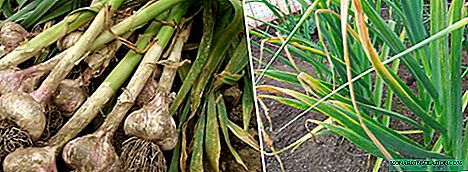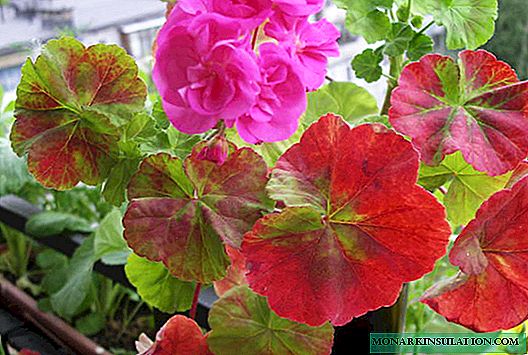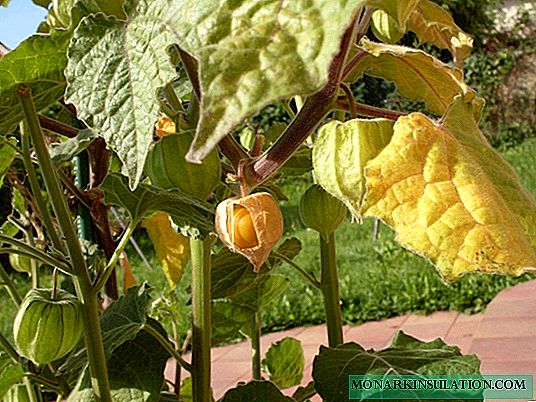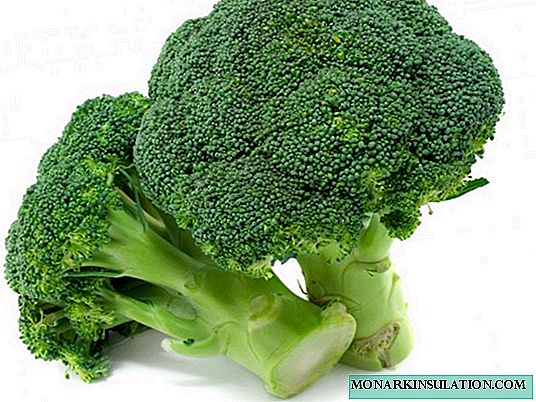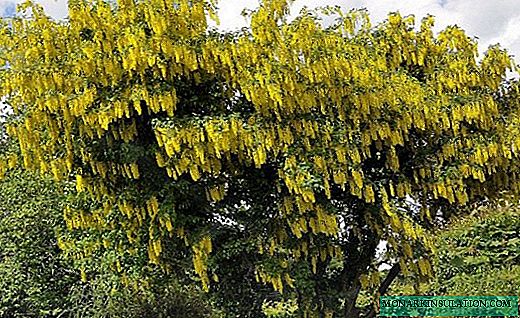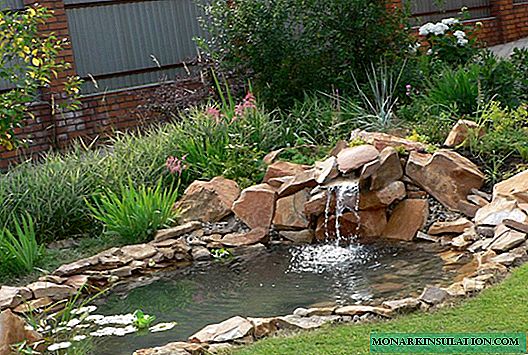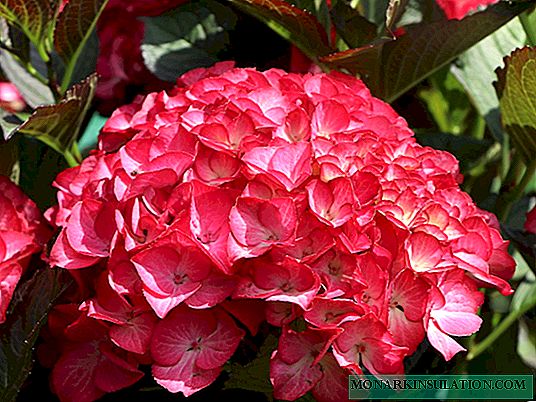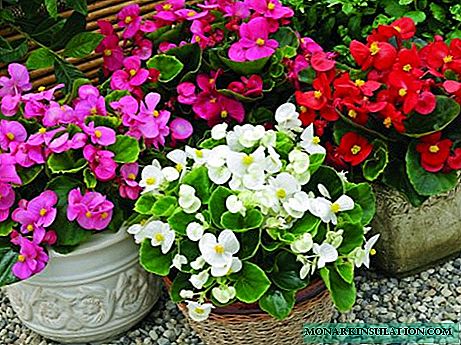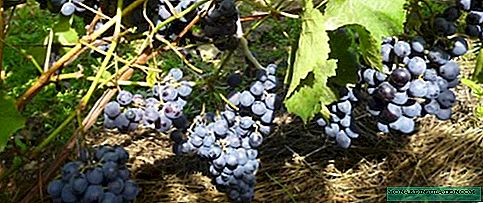
Horticultural crops, which do not require excessive efforts to grow and care, are in great demand today. But they give an opportunity to get a high harvest of tasty and healthy fruits. The Agat Donskoy variety also belongs to such crops. An unpretentious and modest grape that grows even in the harsh conditions of the northern climate.
The history of the cultivation of grape varieties Agat Donskoy
The Agat Donskoy grape variety was obtained in 1986 by crossing a hybrid form of grape (Dawn of the North x Dolores) and Russky Ranniy variety. Selection works were carried out at the experimental base of the All-Russian Research Institute of Viticulture and Winemaking named after Ya.I. Potapenko (VNIIViV im.Ya.I. Potapenko, Russia). The original name of the variety is Vityaz. Under the name Agate Donskoy grapes was included in the State register of selection achievements in 1992.
From parental varieties Agat Donskoy inherited their best qualities:
- Variety Zarya Severa originates from the Michurin Seedling of Malengra, crossed with wild Amur grapes. This variety is characterized by an early ripening period (growing season - 120 days), high frost resistance (up to -32ºC) and resistance to mildew disease. It is used mainly as a technical grape variety.
- Dolores variety was obtained from selection of varieties (Nimrang + Amursky). Its characteristic features are high palatability of fruits, frost resistance, good transportability of the crop.
- The Russian early variety has a very early ripening period (vegetation 105-110 days), fruits with a high sugar content (17-21%), stable good yield, frost resistance up to -23ºC, medium resistance in fungal diseases (mildew, oidium, gray rot).
Photo Gallery: Parent Agat Donskoy grape varieties
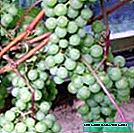
- Advantages: resistance to frost and fungal diseases. Disadvantage: it does not tolerate drought

- Advantages: high quality fruits, winter hardiness. Disadvantages: susceptibility to fungal diseases
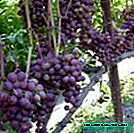
- Advantages: super early ripening and high palatability of fruits. Disadvantages: slowly builds up wood, the first 3 years low yield
Video: presentation of Agate Donskoy grapes
Description of grape Agate Donskoy
- The variety belongs to vigorous. The degree of shoot ripening is high, up to 75-80%.
- The bush has a well-branched, multi-tiered root system. Calcaneal roots deep in the ground.
- The inflorescences of grapes are bisexual, which contributes to the self-pollination of bushes.
- Bunches of grapes of medium density, cone-shaped, above average size, weighing from 400 to 600 grams.
- The fruits are round, dark blue in color with a characteristic waxy coating (spring). The shell of the fruit is strong, edible, the pulp is dense, crisp. The mass of one berry is 4-6 g.
- The taste of berries is pleasant, but simple, without aroma. Sugar content of fruits is average - 14-15%. Tasting score 3.8 out of 5 points.

Variety Agat Donskoy has bisexual flowers, therefore, does not need additional pollination. If necessary, can serve as a pollinator donor for other varieties
The quantity and quality of the crop are directly dependent on the power of the bush, the strength of its growth. With an increase in the growth force, the yield increases infinitely, its quality improves, the size of the clusters and berries, the number of shoots on the bush, the growth of each shoot increases. If the plant is provided with all living conditions, then the crop cannot be limited by anything.
A.S. Merzhanian, doctor s. sciences, professorHousehold Management Magazine, No. 6, June 2017
Grade characteristics
Agate Donskoy grapes in terms of fruiting is early, the growing season is from 115 to 120 days. Harvest in the middle lane ripens in late August and early September (in the southern regions - on the twentieth of August). The variety has a high, stable yield. From one bush when growing in a household you can get up to 50 kg of berries. This explains the tendency of the bushes to overload the crop, which leads to a delay in ripening and weakening of the bush. For stable fruiting, the crop is rationed: one or two fruit clusters are left on a single vine when pruning.
This grape variety has a number of characteristic features. These include:
- unpretentiousness in leaving;
- good ripening of the vine;
- the number of stepsons on the vine is small, which facilitates the care of grapes in the summer;
- high frost resistance, wood and flower buds are not damaged at temperatures up to -26ºС; thanks to this, adult bushes can not be covered for the winter;
- resistance to the main fungal diseases - mildew, gray rot, oidium;
- excellent fruit storing, when storing bunches in a cool place in a suspended form, the berries do not lose their taste for 2-3 months;
- universality of the variety - the fruits are suitable both for fresh consumption and for processing into juices, fruit drinks, wine, and freezing.

Due to the coating of berries with a wax coating (spring), they retain their presentation, durability for a long time and are suitable for transportation
The berries of Agat Donskoy grapes have an interesting property: the longer the bunch hangs on the vine, the greater their sugar content. Therefore, experienced growers do not recommend rushing to harvest, especially if August is sunny and warm.
Propagated Agate Donskoy grapes layering, green and lignified cuttings. Due to the unpretentiousness in care, with a competent planting, young seedlings take root without any problems. Also, the characteristics of the variety include reduced yield of bushes within two to three years after planting. This is due to the plant growing adult wood. After the final design of the wood, the yield of the bush increases and reaches its maximum performance.
Features of planting and growing grapes Agat Donskoy
Due to its high frost resistance, the geography of Agat Donskoy grape cultivation is quite extensive. It is suitable for cultivation in non-covering culture in the areas of sheltering viticulture: in the Central, Central Black Earth regions, in the Volga region, Northwest region, as well as in the Urals, Western Siberia and the Far East.
Landing Features
In the general culture of cultivation, light, open areas that are well warmed by the sun and are not obscured by tall buildings or trees are chosen for planting grapes.
- Vine bushes do not tolerate shading. When planting next to the building, they should be planted on the south or south-west side of the house at a distance of no closer than 2 m. Strong-growing trees should be located on the north, east or west side no closer than 5 m from the grape seedlings, shrubs - no closer than 2 m. Rows the vineyard should be oriented from north to south, so that the plants are evenly lit by the sun throughout the day.
- The lowlands and hollows are not suitable for cultivation, since they accumulate dampness, and there is a real danger of damage to the vineyards in winter frosts, as well as sudden frosts in autumn and late spring. If the site has a rugged topography, then grapes are planted on the southern or southwestern slopes.
- Grapes of the Agat Donskoy variety do not differ in special requirements for the composition of the soil, grows well on various types of soils. However, the most favorable for it are gravelly or stony, well-drained and warmed up. If the soil on the site is diverse in fertility, then a less fertile soil is allocated for the vineyard than for other crops. Grapes should not be planted where groundwater rises closer than 1.5 m to the surface of the soil. The plant does not tolerate a high content of lime and salts. It is desirable that the soil reaction is neutral or slightly alkaline (pH 6.5-7). Good results are obtained by planting grapes in places with deep loose soil, on filled pits, construction sites, places of former construction sites where soils contain an admixture of construction debris, rocky debris, sand and decomposed organic residues.
- If you plan to grow grapes as a wall culture, bushes are planted 1 m from the wall. Brickwork, roofing and walls of houses create a favorable microclimate for the growth and fruiting of bushes.
- Considering that grapes by nature are a vine that quickly forms a long flexible stem, it is usually sent to the roof of the building, balcony and other supports. Therefore, the Agat Donskoy variety is good in arched and arbor moldings, in wall culture. As a rule, a bush is planted in one place, while its crown with the crop may be in another place convenient for you. The territory of the site in this case is used more rationally.

Using the roof of the veranda for fastening the vines allows the bunches to receive lighting and heat throughout the day
We take into account when planting ... If the grapes are greatly obscured by neighbors (growing between trees or bushes), then the harvest on it can be expected for years. The conclusion is this: grapes grow well and bear fruit only in the open, no plants should obscure it from early morning to evening. This is the best option, you need to strive for it as much as possible. After all, grapes can obscure even oneself, if you leave too many shoots - this fact indicates how important sunlight is to the grape bush.
HE. Andrianova, amateur winegrower, SaratovGardens of Russia Magazine, No. 2, May 2010
The most favorable time for planting seedlings is early spring, before the buds open and the vegetation begins. In mid-May and early June, when the threat of frost passes, vegetative seedlings with a closed root system are ready for planting. The growth and development of grapes depends heavily on warming the soil and the surrounding air: the plant goes into a dormant state when the temperature drops below 10ºC. Therefore, seedlings are best planted when the soil warms up above +15ºFROM.
Video: planting a seedling with a closed root system
Long-term observations of winegrowers convince: if the soil on the plot is fertile, with a predominance of black soil and sandstone, then when planting grape seedlings, you should not get too carried away by fertilizing the planting pit. This can provoke the plant to increase the green mass of the leaves to the detriment of the formation and growth of future fruiting shoots and flower buds, the so-called fattening. In this case, clean garden soil with a minimal addition of fertilizers, especially nitrogen, is best for planting. On top of the nutrient mixture, clean soil should be poured into the planting pit and only after that plant a seedling.
If a seedling with an open root system is planted, it should be prepared in a certain way before planting.
- 1-2 days before planting, it is recommended to keep the seedlings in water (you can add a drug to the water to stimulate rooting of Kornevin). This will create moisture in the shoots and roots.
- On the sapling, 2-3 of the most developed shoots are selected (of which the fruiting arrows will go later). These shoots are cut into two or three buds. The remaining shoots are removed.
- The main roots of the seedling, which will subsequently become the main element of the bush nutrition, are cut to a length of 15-20 cm. The remaining roots are also removed.
In case of a high-standard formation of bushes during planting, the distance should be observed: between the bushes - from 1.3 to 1.8 m; between rows - from 2 to 3.5 m.

When planting a seedling, it is necessary to withstand the depth of the root system in the planting pit (about 60 cm), the lignified area of the plant should be completely in the ground
Piggy bank of experience. There is a direct correlation between the development of the root system and the aerial parts of plants. No roots - no harvest! Therefore, the first task of the winegrower is to grow good roots and protect them from freezing. To do this, the bushes are planted to a depth of at least 50-60 cm - away from frost. Even if the seedling is small, with a short stem. In this case, planting is best done in the spring, but do not fill up the landing pit immediately to the entire height, but do it gradually throughout the summer (or even 2 seasons) as the shoot grows and lignifies. The soil in the planting pit measuring 70x70x70 cm should be well cultivated using deep transshipment with the introduction of the right amount of organic and mineral fertilizers. Subject to these rules, the root system of the bush will grow powerful, at a sufficient depth, inaccessible to frost.
HE. Andrianova, amateur winegrower, SaratovGardens of Russia Magazine, No. 2, May 2010
Watering grapes
Watering is one of the main stages in the agricultural technology of grapes. Annual seedlings are especially in need of moisture. During the first month after planting, they must be watered once a week, provided that there is enough rain. Then go to watering once every 2-3 weeks. In August, watering is stopped to stimulate the ripening of the vines.
Photo gallery: methods of watering grape bushes
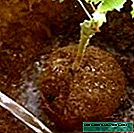
- One-year-old seedling is watered in a hole, the water flow rate is from 5 to 15 liters. After completely absorbing water, the hole is covered with earth and mulched
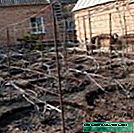
- Bushes older than two years can be watered in tree trunks. After watering, the earth around the stem is mulched with peat or compost
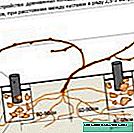
- The best way to water adult bushes is in drainage wells. Water is delivered directly to the roots of the plant, avoiding evaporation and loss.
Grapes, as a culture are more drought-tolerant than moisture-loving, need rare but plentiful watering. Variety Agat Donskoy is early, and for its bushes older than two years, three times of watering during the growing season and water-charging (winter) watering in late autumn are enough. In spring, grapes are watered during budding (ten days before flowering) and two weeks after flowering. It is strictly not recommended to water the grapes during flowering, as this entails the dropping of bushes of flowers. The next watering is done in the summer during the period when the fruits begin to grow and ripen (about 15 days after the previous one). The average water consumption per bush is 40-60 liters. However, three weeks before the fruit fully ripens, watering should be reduced, and stopped completely in 7-10 days to avoid cracking of the berries.
Video: watering grapes in summer
In autumn, at the end of leaf fall or after its completion, water-charging is irrigated. It contributes to better ripening of the vine, activates the growth of roots, resulting in significantly increased winter hardiness of the bushes. To preserve the required moisture level in the soil, mulching is used. As mulch, mowed siderates (mustard, clover, lupine), peat, humus, and overripe straw are used. A good effect is given by sheltering the soil under the bushes with a black film or spanbond.
Fertilizing grape bushes
Feeding grapes is vital. It is produced annually during the growing season and fruiting, introducing the necessary nutrients as the bushes grow and develop, and then the fruits ripen. Top dressing is divided into root (with the introduction of nutrients into the soil) and foliar (with spraying of vegetative organs). In addition to top dressing, under the vine bushes make mineral and organic fertilizers. The main part of the fertilizer is laid when the seedling is planted in the planting pit. Then the bush is fertilized after 2-3 years. The best time for fertilizing is considered autumn. Fertilizing is combined with deep digging of the soil between the bushes of grapes. In the intervals between fertilizers, plants are fed.
Table: root dressing
| Application Period fertilizer | Root dressing (on 1 m²) | Note | |
| Organic fertilizer | Mineral fertilizers | ||
| Early spring (before opening bushes) | - | 10 g of ammonium nitrate + 20 g superphosphate + 5 g of potassium sulfate on 10 l of water | Instead of mineral fertilizer can be used any complex fertilizer (nitrofoska, azofoska, ammofoska) according to the instructions |
| Before flowering (for 1 week) | 2 kg of humus on 10 l of water | 60-70 g nitrofoski + 7 g of boric acid on 10 l of water | Humus is bred in 5 liters of water and insist 5-7 days received the solution is adjusted with water to a volume of 10 l |
| After flowering (2 weeks before ovary formation) | - | 20 g of ammonium nitrate + 10 g of kalimagnesia on 10 l of water | - |
| Before harvest (in 2-3 weeks) | - | 20 g superphosphate + 20 g sulphate potassium per 10 liters of water | Instead of potassium sulfate, you can use any potassium salt (chlorine free) |
| After harvest | - | 20 g of potassium sulfate (or 20 g of Kalimagnesia) on 10 l of water | - |
| In the fall September October (1 time in three years) | 2 kg of humus (compost) under digging | 100 g superphosphate + 100 g of wood ash + 50 g of ammonium sulfate - for digging | MicroMix Universal, Polydon Iodine or any mineral complex with trace elements - according instructions |
Video: how to properly feed grapes
Any top dressing of grapes is carried out only at a positive air temperature (usually not lower than +15ºFROM). In spring and summer, it is recommended to top dress with nutrient solutions, in autumn - in dry form under deep digging of the soil. All types of top dressing are applied over the area of the trunk circle. Liquid top dressing should be combined with watering to avoid burns to the root system. Then the soil under the bushes is mulched. The poorer the soil at the grape growing area, the more often you need to fertilize the soil:
- chernozems - once every 3 years;
- loamy sand, loam - once every 2 years;
- light sandstones - annually.
A good effect is given by spraying grape bushes before flowering with a solution of boric acid, and after flowering with zinc sulfate. These treatments strengthen the vitality of grapes, increase the resistance of the culture to disease.
Table: foliar top dressing
| Application Period fertilizer | Foliar top dressing (per 1 bush) | |
| Mineral fertilizers | Possible replacement drugs | |
| 3 to 5 days before flowering | 5 g of boric acid on 10 l of water. Combine with processing fungicides | Nitrofoska, azofoska, ammonia saltpeter (in accordance with instruction) |
| In 5 to 10 days after flowering | 50 g of wood ash on 10 l of water | Ovary, Plantafol, Aquamarine, Kemer, Novofert (in according to the instructions) |
| 15 days after previous processing | Ovary according to instructions; 50 g of wood ash on 10 l of water | Ovary, Plantafol, Aquamarine, Kemer, Novofert (in according to the instructions) |
| 15 days before ripening and harvesting | 3 g superphosphate + 2 g potassium sulfate on 10 l of water | - |
Video: foliar grape top dressing
Spraying grape bushes should be done in calm weather, preferably in the evening (after 18 hours) or early in the morning (up to 9 hours).
Cutting and shaping grapes
The yield of grapes is regulated by the load of the bush. The load of the bush is the number of fruitful shoots (eyes) that are left on the vine directly during the pruning process. If there is little left after a strong eye trim, then the load will be weak. This will lead to a decrease in yield. Overloading the bush with fruits is also harmful, the plant weakens, gets sick and next year the yield of grapes may decrease. The optimal load of the bush is determined in the process of its growth and development of the vine. For a two-year plant, it is 50% of the norm recommended for fruit bearing bushes, for a three-year plant - 75-80% of this norm.
Video: the formation of the annual agate bush Agat Donskoy
To obtain a stable crop, the vine should be pruned annually. In autumn, after leaf fall, the stems are shortened to the level of the 3rd or 4th kidney. In a two-year-old plant, four highly developed and healthy shoots are left, and the rest are cut out. Then they are shortened to the 5th kidney. A three-year-old correctly trimmed bush carries 4 fruiting vines. To build strength, the number of fruit stems is increased on average to three per vine, with a general increase in the number of vines. For Agate Donskoy grapes, pruning of fruiting shoots is usually done for 5-8 eyes, but 4-6 eyes are allowed. An average of 35 to 45 eyes are left on the bush.
Video: grape pruning on the gazebo
When the green berries of the grapes begin to change their color, this means that the period of ripening of the fruits begins. At this time, the vine bushes cease to grow and the lignification of the bark begins. This process continues throughout August. At the same time, young shoots from green turn into brown, which is caused by the maturation of their lower part. A sign of slower growth of shoots is the straightening of their tops. In the period of slowing and stopping growth, the so-called chasing is performed, in which the tops of shoots with young underdeveloped leaves are cut off. Chasing contributes to the final stop of vine growth and activates the maturation of wood. For vigorous grape varieties, chasing is of particular importance. With this type of pruning, shoots (especially root ones) and fatliquoring shoots of annual growth are also removed. If the summer is dry, then the coinage must be abandoned.
Since the vine is a vine and grows long shoots during the growing season, its biennial and fruit-bearing shoots are fixed on supports. When growing grapes in a homestead or summer cottage, the following support systems are used: trellis, gazebo, parietal, stake. The most common is a trellis system.
The trellis is a construction of pillars (reinforced concrete, metal or wood) and wire (preferably galvanized). The shoots mounted on the trellises are sufficiently and evenly ventilated, they receive the same amount of heat and sunlight. In addition, the location of the stems above the ground creates convenience for the gardener when caring for plants and harvesting.

Fixing grape shoots on a trellis allows them to develop freely and receive a sufficient amount of light and heat
Recently, the palpless capitate formation of the grape bush has spread. This formation is advisable to apply if the garden plot is small or not possible to grow grapes according to the classical pattern - in rows. The tapestry-free formation gives the wine-grower a number of advantages:
- the space of the plot is used economically, it is possible to place the bush in any suitable place;
- no garter of the vine is required, and freely hanging shoots grow slower in length;
- clusters of grapes are located high above the ground, are well ventilated and receive enough heat and sunlight, which means they are less susceptible to disease;
- the absence of supports and wire for garter shoots reduces material and labor costs.
Video: tapestry capitate grape formation
Fight against diseases and pests of grapes
Due to its varietal qualities, Agate Donskoy grapes have an increased integrated resistance to fungal diseases. However, for prophylaxis, especially in summer during a period of high air temperature and high humidity, it is necessary to spray grape bushes with fungicides. The best option is to treat the plants with Phytosporin with the addition of Zircon. During the growing season, two treatments with these drugs are sufficient: after flowering during the fruit set period and two weeks after the first treatment. Spraying the bushes should be done in strict accordance with the instructions. Do not process grapes later than 2-3 weeks before harvesting.
If nevertheless signs of fungal diseases appear on the grapes, it is necessary to immediately spray the bushes with preparations from a specific type of disease:
- from mildew use the fungicides Radomil or Amistar;
- from defeat by oidium apply Thanos or Profit;
- gray rot will be destroyed by Ronilan, Rovral, Sumileks.
Photo gallery: signs of the main fungal diseases of grapes
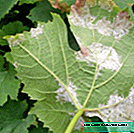
- A characteristic white coating forms on the back of the leaf, which extends to the ovaries

- Oidium spores affect all parts of the vine bush, including shoots, castings and fruits
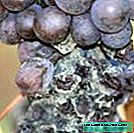
- Characteristic signs of gray rot: brownish-white coating on the leaves and rotting wrinkled berries
The fruits of Agate Donskoy grapes do not have high sugar content, so wasps usually do not damage them. If necessary, to protect against wasps, you can spray the shoots with a solution of mustard powder (200 g of powder per bucket of water).
Shelter of grape bushes for the winter
Despite the high frost resistance and uncultivated culture, in very severe frosts (especially in the northern regions of cultivation) and in snowy winters, Agat Donskoy grapes require protection of the vines for the winter period. Shelter for the winter for one-two-year-old seedlings is a prerequisite.
Video: Shelter of an annual grape seedling
Adult vine bushes protect against winter colds by bending them to the ground. So that the plants do not touch the ground, it is advisable to put boards, wooden blocks, non-woven material under them. Removed from the trellis and trimmed vine carefully twisted and laid on prepared surfaces, securing with hooks or arches. From above, shoots are covered with burlap, non-woven material or polypropylene bags in several layers. You can also use pine fern. In any case, the space inside should be breathable, so you can not cover them with a film. Wooden shields, slate, linoleum, ruberoid or polycarbonate sheets are laid on top of the covered plants. The edges of the structure are securely fixed with bricks or simply covered with a layer of earth. In winter, it is useful to additionally throw snow at a shelter, increasing the height of the snowdrift.
Usually around the end of October, I take my grapes off the trellis, cut them off, always leaving 3-4 large vines, and each one has 1 knot of substitution and 1 fruiting vine. I remove the weak and crooked shoots coming from the root, and cut off the shoots that have proclaimed in the current year also to the fruiting vine, without leaving a hemp. Old and clumsy shoots, with cracked bark, coming from the root, cut out at the base. After I cut the whole grape, I lay it on the ground, pressing the vines with sticks so that they do not spring. So he waits until spring.
O. Strogova, experienced viticulturist, SamaraHousehold Management Magazine, No. 6, June 2012
Video: winter shelter for adult bushes
Reviews
Hello. Agate Donskoy is good, but inferior in taste. The taste is mediocre. Usually in compote, no more. With a short cropping and normalization, it turns out to be larger and tastier, but anyway it lags behind the same KODYRKA. PROS: Never gets sick. Winters without shelter and without loss.
Vladimir, Anna Voronezh, Russia//forum.vinograd.info/showthread.php?t=1068&page=3
Hello everyone! Today removed the last bunches of Agat Donskoy. You can summarize. In the tenth year of the bush’s life, very good results were obtained. In total there were 108 clusters with a total weight of 42.2 kg. The average weight of the bunch is 391 g., Maximum 800 g. The length of the trellis is 3.5 m. Sweet, not sugary, you can eat a bunch of 500 gr. right away. Now, indicators more important for the industry: the length of all shoots is about 2 meters - you do not need to mint and do a lot of garters, there is not a single stepson on the whole bush - additional steps disappear. manual work, resistance above all grades (not a single affected leaf) - no need to conduct chemical. processing etc. For industry - the ideal!
Anatoly Bachinsky, Ukraine//forum.vinograd.info/showthread.php?t=1068
As the classics say, grapes are a culture of time and PLACES. I want to draw attention to the highlighted word. If in the south you can raise a "workhorse" with higher taste qualities than AGAT DONSKAYA, then the northerners are almost impossible to achieve this. So for us, this variety remains one of the most reliable and ripening berries and vines in all respects.
Alexander, Zelenograd, Moscow region//forum.vinograd.info/showthread.php?t=1068&page=5
Armed with the knowledge gained, it is time to go to a personal or garden plot and choose a place for planting Agat Donskoy grapes. If you apply diligence and patience, you will get a garden culture that will delight you with large ripe bunches of grapes for many years.










